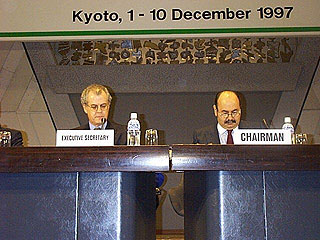|
|
 |
|
|
|
 |
| |
|
|
 |
How are
people changing
the climate?
Basics |
3. How can we hinder
man-made climate change?
International cooperation
Because the climate issue affects the entire world, international cooperation is needed to find truly effective solutions. Thus, since the end of the 1980s, international negotiations have been taking place to agree on how to limit emissions. At present there are two important international agreements on combating man-made climate change. |
|
|
|
|
 |
(the United Nations’ Framework Convention on Climate Change (UNFCCC ), also known as “the Climate Convention”) from 1992 was signed by most of the countries in the world. The UNFCCC says that every country should work to combat dangerous climate changes, and gave the developed countries the greatest burden of responsibility. The UNFCCC forms the basis for further cooperation, and the signatories meet every year to discuss new steps to take to fight climate change. You can read more about the Climate Convention here.
|
 |
 |
|
1. THE KYOTO PROTOCOL: in 1997 the Climate Convention held a conference in Kyoto, Japan for agreeing on a treaty that would require the industrialised world to limit its emissions of greenhouse gases. Photo: IISD (Click to enlarge, 81 kB)
|
|
 |
- The Kyoto Protocol from 1997 is a follow up to the UNFCCC. It sets targets for emissions reductions for each of the developed countries for the period 2008–2012. More than one hundred countries have signed this agreement, but the country responsible for the highest emissions rate – the United States – has withdrawn its support. Read more about the Kyoto Protocol here.
|
|
To fulfill the requirements of the Kyoto Protocol, the governments of each country must take action, such as described in the unit “What can the government do?”
|
|
This was the last page in this unit. Go to worksheets. |
|
Author: Camilla Schreiner - CICERO (Center for International Climate and Environmental Research - Oslo) - Norway. Scientific reviewers: Andreas Tjernshaugen - CICERO (Center for International Climate and Environmental Research - Oslo) - Norway - 2004-01-20 and Knut Alfsen - Statistics Norway - Norway - 2003-09-12. Educational reviewer: Nina Arnesen - Marienlyst school in Oslo - Norway - 2004-03-10. Last update: 2004-03-27. |
|
 |
|









